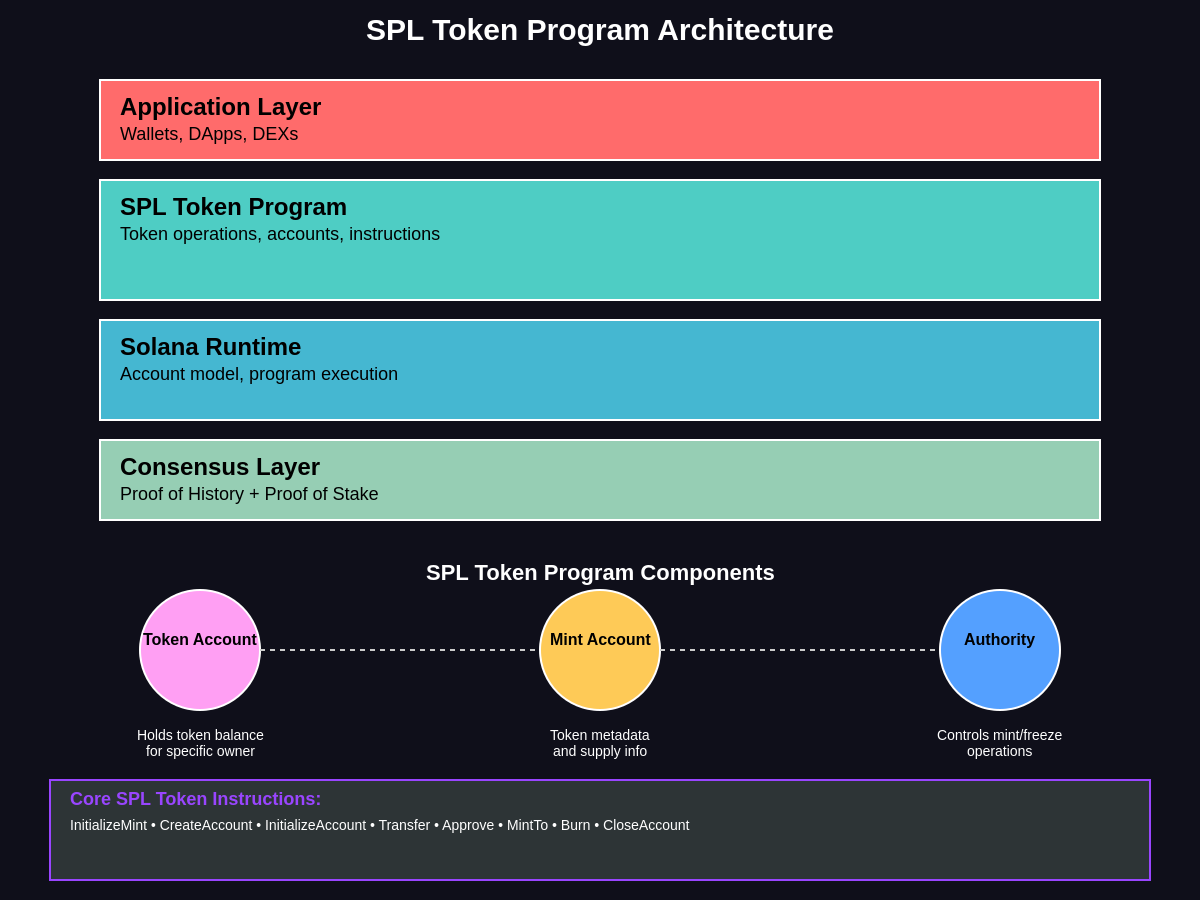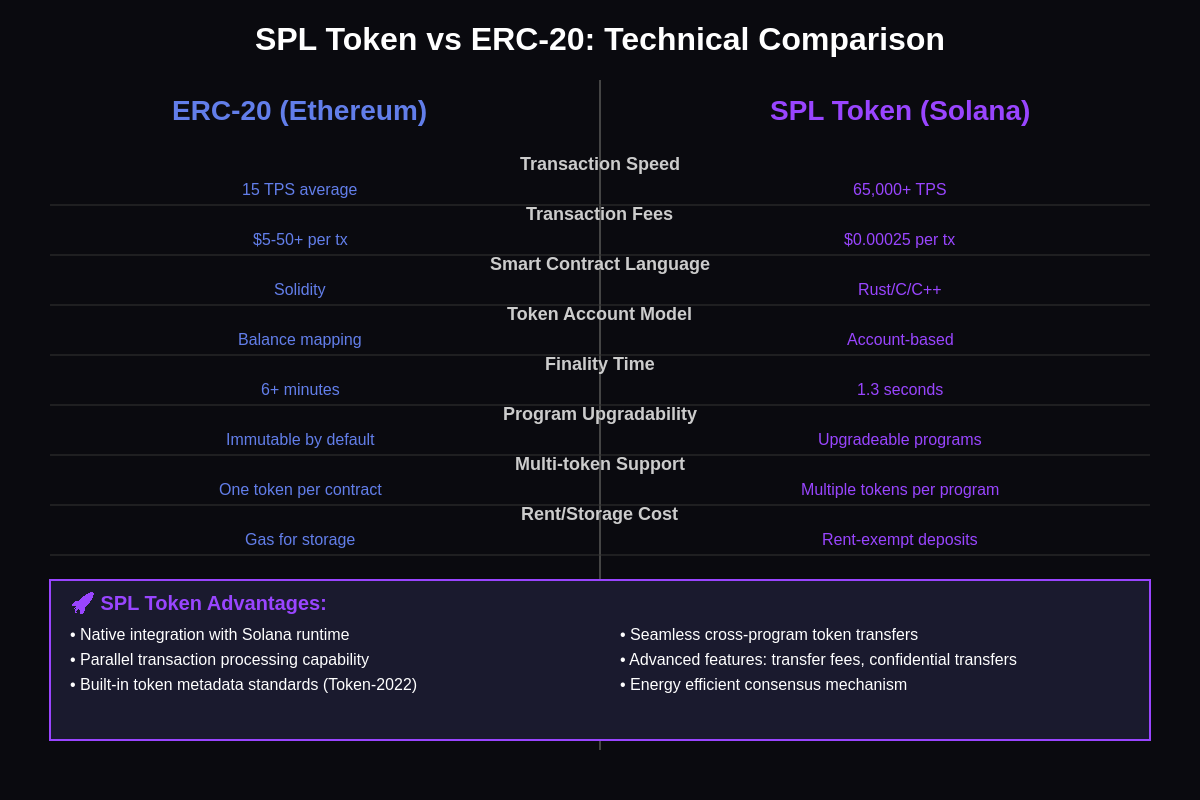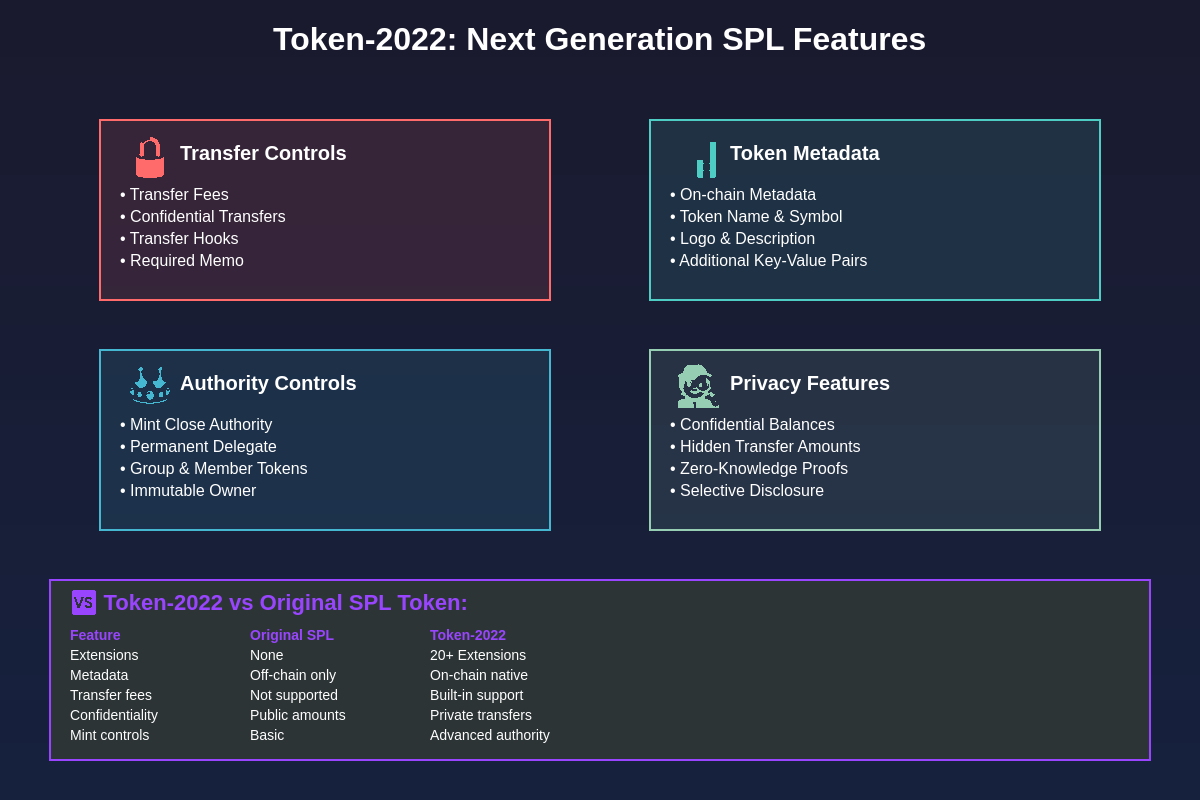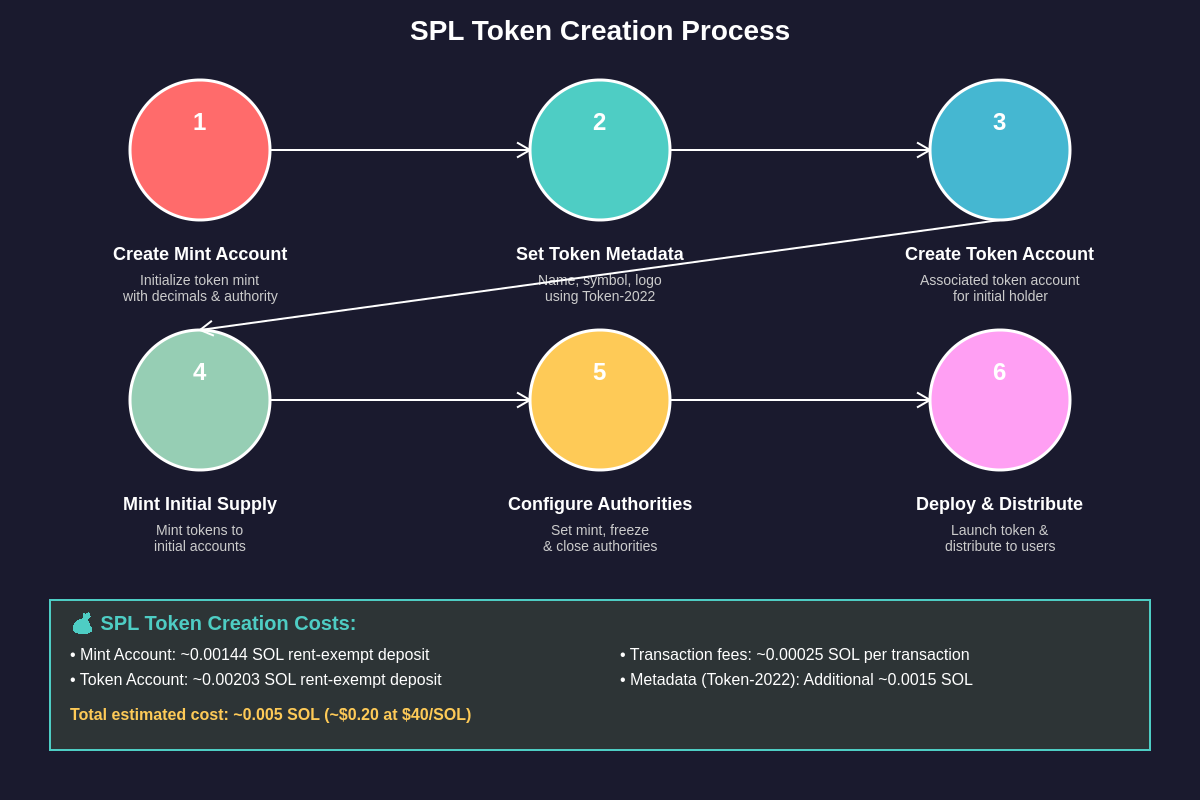Explore advanced token analytics and trading strategies on TradingView to maximize your SPL token investments with professional-grade tools and real-time market data.
The Evolution of Token Standards in Blockchain
The Solana Program Library Token Standard, commonly known as SPL Token, represents a fundamental advancement in blockchain token architecture that addresses many of the scalability and cost limitations associated with Ethereum’s ERC-20 standard. As decentralized finance continues to expand and institutional adoption accelerates, the need for more efficient token standards has become increasingly apparent, leading to innovative solutions like SPL Token that prioritize speed, cost-effectiveness, and developer flexibility while maintaining the security and functionality that users expect from modern cryptocurrency systems.
The development of SPL Token emerged from Solana’s unique architectural approach to blockchain design, which emphasizes parallel processing, low transaction costs, and high throughput capabilities that can support global-scale applications. Unlike traditional blockchain architectures that process transactions sequentially, Solana’s innovative design allows for concurrent transaction processing, enabling the network to achieve theoretical throughput of over 65,000 transactions per second while maintaining transaction costs below a fraction of a cent.
The significance of SPL Token extends beyond mere technical specifications to encompass a broader vision of how decentralized applications should function in a post-scalability world where users expect near-instant confirmations and minimal fees. This paradigm shift has profound implications for everything from simple token transfers to complex DeFi protocols, gaming applications, and enterprise blockchain solutions that require high-performance token functionality without the prohibitive costs associated with congested networks.
Architectural Foundations and Core Design Principles
The SPL Token standard builds upon Solana’s account-based model, which differs fundamentally from Ethereum’s balance mapping approach by treating each token holding as a separate account with its own state and ownership structure. This architectural decision enables more granular control over token operations while facilitating parallel processing of token transactions, as each token account can be modified independently without requiring global state synchronization that often creates bottlenecks in other blockchain systems.
The core design philosophy behind SPL Token emphasizes modularity, extensibility, and composability, allowing developers to create sophisticated token economies without sacrificing performance or incurring excessive operational costs. The standard defines clear separation between mint accounts, which contain token metadata and supply information, and token accounts, which hold individual user balances, creating a flexible framework that can accommodate various token distribution models and governance structures while maintaining consistency across different implementations.
SPL Token’s integration with Solana’s runtime environment provides native support for complex token operations including atomic swaps, multi-signature transactions, and programmatic token management through smart contracts written in Rust, C, or C++. This low-level integration ensures that token operations benefit from Solana’s optimization techniques including parallel execution, efficient memory management, and streamlined transaction processing that collectively contribute to the network’s exceptional performance characteristics.
The standard’s emphasis on rent-exempt account management addresses one of the significant challenges facing blockchain scalability by requiring small deposits to maintain account state while providing mechanisms for account closure and rent reclamation. This approach ensures that the network’s state growth remains manageable while providing users with predictable costs for token account maintenance and operation.
Technical Implementation and Smart Contract Architecture
SPL Token implementation relies on a sophisticated program architecture that separates token logic from individual token instances, allowing for efficient code reuse and standardized functionality across all tokens built on the platform. The SPL Token Program serves as a singleton contract that handles all token operations system-wide, eliminating the need for individual token contracts and reducing both deployment costs and potential security vulnerabilities associated with custom implementations.

The program’s instruction set includes fundamental operations such as InitializeMint for creating new token types, CreateAccount for establishing token holdings, Transfer for moving tokens between accounts, and specialized instructions like MintTo and Burn that allow authorized parties to modify token supply. Each instruction undergoes rigorous validation to ensure compliance with token policies and proper authorization, providing robust security guarantees while maintaining high execution speed.
Advanced SPL Token features include support for multi-signature authorities, where multiple parties must approve certain operations like minting or freezing, and delegation mechanisms that allow token holders to authorize third parties to transfer tokens on their behalf without exposing private keys. These features enable sophisticated DeFi applications including automated market makers, yield farming protocols, and decentralized exchanges that require programmatic token management capabilities.
The integration with Solana’s Proof of History consensus mechanism ensures that all token operations are ordered chronologically and verified cryptographically, providing strong consistency guarantees while enabling parallel processing of non-conflicting transactions. This temporal ordering system eliminates many of the race conditions and front-running opportunities that plague other blockchain networks, creating a more fair and predictable environment for token-based applications.
Comparison with ERC-20 and Other Token Standards
The performance differential between SPL Token and ERC-20 is substantial, with SPL Token transactions typically confirming in 1.3 seconds compared to Ethereum’s average of 15 seconds to several minutes, while transaction costs remain consistently below $0.001 compared to Ethereum’s highly variable fees that can range from $5 to over $100 during network congestion. This dramatic improvement in user experience makes SPL Token particularly suitable for applications requiring frequent token interactions, such as gaming, micropayments, and high-frequency trading systems.

Monitor SPL token performance and compare with ERC-20 metrics using comprehensive market analysis tools that provide real-time insights into transaction volumes, price movements, and network adoption trends.
The account model employed by SPL Token provides several advantages over ERC-20’s balance mapping approach, including more efficient state management, easier integration with off-chain systems, and enhanced support for complex token behaviors like automatic fee collection and programmatic token management. Each SPL token account maintains its own state independently, allowing for more granular permissions and reducing the potential impact of smart contract vulnerabilities on user funds.
SPL Token’s native support for features like transfer fees, confidential transfers, and advanced metadata represents a significant evolution beyond the basic functionality provided by ERC-20. These built-in capabilities eliminate the need for wrapper contracts or auxiliary systems that often introduce additional complexity and security risks in Ethereum-based applications, while providing developers with powerful tools for creating sophisticated token economies.
The upgrade path for SPL Token is more streamlined than ERC-20, with new features being added at the program level rather than requiring individual token migrations. This approach ensures that all SPL tokens can benefit from protocol improvements automatically while maintaining backward compatibility with existing applications and user interfaces.
Token-2022: The Next Generation of SPL Tokens
The Token-2022 program represents a major evolution of the SPL Token standard, introducing over twenty extension mechanisms that enable advanced functionality previously impossible with traditional token implementations. These extensions include confidential transfers using zero-knowledge proofs, transfer fees that can be automatically collected by token creators, and comprehensive metadata support that eliminates reliance on off-chain systems for basic token information.

Confidential transfers represent one of the most significant innovations in Token-2022, allowing users to hide transaction amounts while still enabling network validation through zero-knowledge proof systems. This privacy-preserving functionality addresses growing concerns about financial surveillance while maintaining the transparency and auditability that make blockchain systems trustworthy for institutional and regulatory compliance.
The transfer fee extension enables token creators to implement automated fee collection directly at the protocol level, eliminating the need for complex wrapper contracts or external fee management systems. This functionality is particularly valuable for projects implementing tokenomics models that require ongoing revenue generation or liquidity provision fees, as it ensures consistent fee collection regardless of the transfer mechanism used.
Advanced authority controls in Token-2022 include permanent delegate functionality, which allows designated accounts to override normal transfer restrictions, and mint close authority, which provides mechanisms for properly sunsetting token programs when they are no longer needed. These features address governance and lifecycle management challenges that have emerged as DeFi protocols mature and require more sophisticated operational controls.
Developer Experience and Integration Patterns
The developer experience for SPL Token integration has been carefully optimized to reduce complexity while providing comprehensive functionality, with official SDKs available for JavaScript, Rust, Python, and other popular programming languages. These SDKs abstract away low-level transaction construction and account management details while providing high-level interfaces for common operations like token transfers, account creation, and metadata queries.

Integration patterns for SPL Token emphasize composability and interoperability, with standardized interfaces that enable seamless interaction between different protocols and applications. The Associated Token Account (ATA) system provides deterministic addressing for token accounts, eliminating the need for users to manually create token accounts before receiving transfers and significantly improving user experience for wallet applications and DeFi protocols.
Cross-program invocation capabilities allow SPL tokens to be integrated directly into complex smart contracts without requiring external token approvals or multi-step transaction flows. This tight integration enables atomic operations that combine token transfers with other protocol interactions, reducing transaction costs and eliminating failure modes associated with multi-transaction workflows.
The testing and deployment workflow for SPL Token applications benefits from Solana’s local development environment and comprehensive testing frameworks that enable developers to simulate complex token interactions before deploying to mainnet. This robust development toolchain has contributed to the rapid adoption of SPL Token by developers building sophisticated DeFi applications and other token-intensive projects.
Security Model and Risk Assessment
The security model for SPL Token leverages Solana’s account-based architecture to provide strong isolation between different token accounts while maintaining efficient program execution. Each token account is owned by the SPL Token Program, which enforces authorization rules and prevents unauthorized token operations, while individual token holders maintain control through their private keys without needing to interact directly with program code.
Authority management in SPL Token provides flexible security models ranging from fully decentralized tokens with no special authorities to carefully controlled tokens with multi-signature mint and freeze authorities. This flexibility allows projects to implement appropriate security measures based on their specific requirements while providing clear transparency about the level of centralization or decentralization in their token implementation.
The program’s design eliminates many common smart contract vulnerabilities through its use of Rust’s memory safety features and Solana’s runtime security checks, which prevent buffer overflows, integer underflows, and other common attack vectors. Additionally, the separation of program logic from token-specific data reduces the attack surface by eliminating the need for custom contract code that might contain implementation errors.
Audit practices for SPL Token implementations benefit from the standardized program architecture, as security reviews can focus on configuration and integration patterns rather than fundamental token logic. This standardization has led to extensive security analysis of the core SPL Token Program by multiple independent security firms, providing high confidence in the underlying security of all tokens built using the standard.
Economic Implications and Cost Analysis
The economic advantages of SPL Token become particularly pronounced in high-volume applications where transaction costs significantly impact user behavior and protocol profitability. With transaction costs typically below $0.001, SPL Token enables business models that would be economically infeasible on higher-cost networks, including micropayments, frequent small transactions, and complex multi-step protocols that require numerous token operations.
Rent economics in Solana require users to maintain small deposits in token accounts to keep them active, but these deposits are fully recoverable when accounts are closed, creating a more predictable cost structure compared to gas-based systems where fees are permanently consumed. This model encourages responsible account management while ensuring that users retain full control over their deposited funds.
Analyze the economic impact of different token standards and their effect on DeFi protocol profitability using comprehensive market data and cost analysis tools.
The cost predictability of SPL Token operations enables developers to build applications with transparent fee structures and eliminates the user experience problems associated with fluctuating transaction costs. This predictability is particularly valuable for enterprise applications and institutional use cases where cost certainty is essential for business planning and regulatory compliance.
Ecosystem Development and Adoption Metrics
The SPL Token ecosystem has experienced rapid growth since its introduction, with thousands of tokens launched across diverse sectors including DeFi, gaming, NFTs, and enterprise applications. Major DeFi protocols like Serum, Raydium, and Orca have built their entire token economies around SPL Token, demonstrating the standard’s capability to support sophisticated financial applications at scale.
Institutional adoption of SPL Token has been facilitated by its technical advantages and regulatory compliance features, with several major financial institutions and payment processors integrating SPL Token functionality into their digital asset offerings. The standard’s support for compliance features like transfer restrictions and identity verification makes it particularly attractive for regulated use cases.
The developer community around SPL Token has grown substantially, with active open-source development, comprehensive documentation, and educational resources that lower the barrier to entry for new projects. This vibrant ecosystem has produced numerous tools, libraries, and frameworks that accelerate development and reduce the cost of building SPL Token-based applications.
Cross-chain bridge development has enabled SPL Token interoperability with other major blockchain networks, allowing users to move tokens between Solana and networks like Ethereum, Binance Smart Chain, and Polygon. These bridges have expanded the utility of SPL tokens by enabling participation in multi-chain DeFi protocols and providing liquidity options across different blockchain ecosystems.
Advanced Features and Extension Mechanisms
The extension system in Token-2022 provides a framework for adding new functionality to SPL tokens without breaking backward compatibility or requiring migration of existing tokens. This extensible architecture enables rapid innovation and adaptation to new use cases while maintaining the security and performance characteristics that make SPL Token attractive to developers and users.
Transfer hooks represent one of the most powerful extension mechanisms, allowing tokens to execute custom logic during transfer operations. This functionality enables sophisticated behaviors like automatic fee distribution, loyalty point accumulation, and compliance checking without requiring users to interact with additional smart contracts or complex transaction workflows.
The metadata extension provides native support for token names, symbols, descriptions, and arbitrary key-value pairs directly in the token account structure. This on-chain metadata eliminates dependencies on off-chain systems and ensures that token information remains accessible and tamper-resistant, addressing one of the significant limitations of earlier token standards.
Group and member token extensions enable hierarchical token relationships where parent tokens can control or influence child tokens, opening possibilities for complex token economies including multi-tier reward systems, organizational tokens, and sophisticated governance structures that require coordinated token behavior across multiple assets.
Integration with DeFi Protocols and Applications
SPL Token’s integration with major DeFi protocols demonstrates its capability to support sophisticated financial applications while maintaining the performance characteristics that enable high-frequency trading and complex arbitrage strategies. Automated market makers like Raydium and Orca process thousands of SPL token swaps daily with minimal slippage and consistent execution times that enable predictable trading strategies.
Lending protocols built on Solana leverage SPL Token’s efficiency to offer competitive interest rates and rapid settlement times that enhance capital efficiency for both lenders and borrowers. The low transaction costs enable frequent compound operations and automated yield optimization strategies that would be cost-prohibitive on higher-fee networks.
Track DeFi protocol performance and SPL token integration metrics using advanced charting tools and technical indicators designed for cryptocurrency market analysis.
Cross-program composability allows SPL tokens to be integrated into complex DeFi strategies that combine multiple protocols in single transactions, enabling sophisticated financial products like leveraged yield farming, automated portfolio rebalancing, and complex derivatives that require precise timing and low execution costs to remain profitable.
Future Developments and Roadmap Considerations
The future development of SPL Token focuses on enhancing privacy features, improving cross-chain interoperability, and expanding the extension system to support emerging use cases in areas like carbon credits, real-world asset tokenization, and institutional custody solutions. These developments aim to position SPL Token as the preferred standard for next-generation blockchain applications that require both high performance and advanced functionality.
Privacy enhancements planned for future versions include more sophisticated zero-knowledge proof systems, enhanced metadata privacy controls, and improved confidential transfer mechanisms that provide stronger privacy guarantees while maintaining regulatory compliance capabilities. These features address growing demand for financial privacy in blockchain applications while ensuring compatibility with institutional and regulatory requirements.
Interoperability improvements focus on streamlining cross-chain token movement and enabling native SPL token functionality on other blockchain networks through advanced bridge protocols and layer-2 solutions. These developments aim to create a more connected blockchain ecosystem where users can benefit from SPL Token’s advantages regardless of their preferred blockchain platform.
The extension ecosystem continues to evolve with community-driven proposals for new functionality including advanced governance features, automated compliance checking, and integration with emerging technologies like artificial intelligence and Internet of Things applications that require high-performance token systems to enable machine-to-machine value transfer.
Regulatory Compliance and Institutional Considerations
SPL Token’s architecture provides several features that facilitate regulatory compliance and institutional adoption, including native support for transfer restrictions, identity verification requirements, and audit trail generation. These compliance-oriented features enable projects to implement know-your-customer (KYC) and anti-money laundering (AML) procedures directly at the token level without requiring complex wrapper systems or external compliance infrastructure.
The standard’s support for immutable audit logs and transparent transaction history makes it well-suited for regulated environments where transaction monitoring and reporting are required. The efficiency of SPL Token operations also enables real-time compliance monitoring and automated suspicious activity detection that would be cost-prohibitive with higher-fee token standards.
Institutional custody solutions for SPL tokens benefit from the standard’s multi-signature capabilities and advanced authority controls, which enable sophisticated key management practices and operational security procedures. The predictable cost structure of SPL Token operations also simplifies institutional treasury management and enables more accurate cost accounting for blockchain-based operations.
Regulatory clarity around SPL tokens continues to evolve as financial regulators develop frameworks for digital asset classification and oversight. The technical transparency and standardized architecture of SPL Token facilitate regulatory analysis and compliance verification, potentially accelerating approval processes for institutional use cases and regulated financial products.
Performance Optimization and Scalability Considerations
The performance characteristics of SPL Token enable applications that require high transaction throughput and low latency, making it suitable for real-time applications like gaming, micropayments, and high-frequency trading systems. The standard’s integration with Solana’s parallel processing capabilities allows multiple independent token operations to execute simultaneously, maximizing network utilization and minimizing confirmation times.
Optimization strategies for SPL Token applications include efficient account management, batch transaction processing, and strategic use of program-derived addresses to minimize computational overhead. These techniques enable developers to build applications that can handle thousands of transactions per second while maintaining consistent performance characteristics.
Scalability planning for SPL Token implementations benefits from Solana’s horizontal scaling capabilities and planned improvements like stake-weighted quality of service and fee markets that will further enhance network performance. These infrastructure improvements ensure that SPL Token applications can continue to scale as user adoption grows and transaction volumes increase.
The development of layer-2 solutions and state compression techniques for Solana will further enhance SPL Token scalability by enabling even higher transaction throughput and lower costs for specific use cases like gaming and micropayments where millions of small transactions may be required.
Conclusion and Market Implications
SPL Token represents a significant advancement in blockchain token standards that addresses fundamental limitations of earlier implementations while providing a foundation for next-generation decentralized applications. The combination of high performance, low costs, and advanced functionality positions SPL Token as a critical infrastructure component for the continued growth and maturation of the cryptocurrency ecosystem.
The success of SPL Token demonstrates the importance of holistic blockchain architecture design, where token standards are developed in conjunction with consensus mechanisms, runtime environments, and developer tools to create cohesive systems that deliver superior user experiences. This integrated approach has enabled Solana to attract significant developer activity and institutional interest while maintaining technical leadership in blockchain performance metrics.
As the cryptocurrency industry continues to evolve toward mainstream adoption, standards like SPL Token that prioritize user experience, cost efficiency, and developer accessibility will likely play increasingly important roles in determining which blockchain networks achieve widespread adoption. The ongoing development of advanced features and extension mechanisms ensures that SPL Token will continue to adapt to emerging use cases and market requirements.
Stay informed about SPL token market developments and trading opportunities with professional-grade analysis tools and real-time market data that help traders and investors make informed decisions in the rapidly evolving cryptocurrency landscape.
The broader implications of SPL Token’s success extend beyond technical considerations to encompass questions about the future structure of global financial systems, the role of programmable money in digital economies, and the potential for blockchain technology to enable new forms of economic organization and value creation that were previously impossible with traditional financial infrastructure.
Disclaimer: This article is for informational purposes only and does not constitute financial advice. Cryptocurrency investments carry significant risks, including the potential for total loss of capital. The SPL token standard and Solana blockchain technology are subject to ongoing development and may experience technical issues or security vulnerabilities. Readers should conduct their own research and consult with qualified financial advisors before making investment decisions. The author and publisher are not responsible for any financial losses or damages resulting from the use of information contained in this article. Always invest only what you can afford to lose and be aware that cryptocurrency markets are highly volatile and speculative.